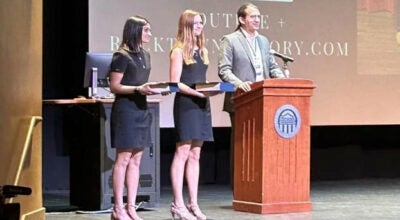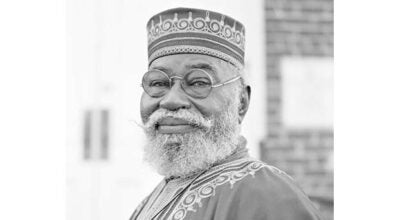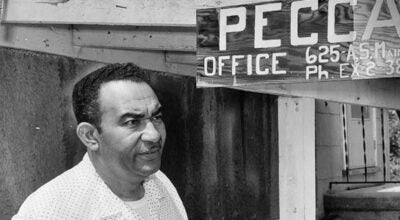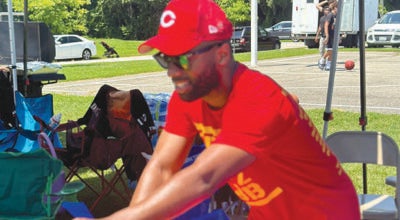Anthony Anderson: As we see progress, we will continue the march
Published 12:12 am Monday, May 6, 2024
|
Getting your Trinity Audio player ready...
|
Like many students at Longwood University, I have immersed myself in the campus culture. I strive to live out the mission of citizen leadership by engulfing myself in all facets of campus life. Since transferring to Longwood about three years ago, I have participated in service projects, joined student organizations, and currently serve as the Editor-In-Chief of the University’s independent student-run news organization. I have not only embraced life at Longwood but also living in the Farmville community. Barbara Rose Johns’ legacy is all the more impactful for my peers and me but unlike just under 90% of my peers, I am a Black man.
Including myself, there are 329 people of color identified among the 3,222 currently enrolled undergraduate students on Longwood’s campus, according to the university’s reported data in October 2023 to the State Council for Higher Education for Virginia (SCHEV) in their fall 2023 headcount race trends. That is 10.2% of the student body. Although 329 students might not sound like a lot, it is another step in the right direction for a university whose administration largely stood silently during and after Barbara Rose Johns and her classmates walked out of the Robert Russa Moton High School in April 1951.
We see progress through the years
Since the historic 1954 ruling of Brown v. Board of Education, the university leadership has worked to be a more inclusive institution of higher education. The first Black student in university history, Barbara Botts, enrolled in 1966, and N.H. “Cookie” Scott became the university’s first Black graduate in 1972. The cultural change was for more than just who was admitted, but also reflected who was hired to provide expertise and support. Dr. Edna Allen Bledsoe Dean became the first full-time tenured Black academic faculty member in 1980. Her legacy is honored and remembered through Allen Hall.
Going into the turn of the century and beyond, university leadership did not forget its aim to enhance its campus’s diversity, equity, and inclusion. In 2015, Longwood’s governing body, the Board Of Visitors, approved a statement of profound regret for the university’s action during the civil rights era. In 2020, the current iteration of the Office of Multicultural Affairs was established and the Clark Intercultural Center was established.
Clark House as it is known to students, is a space where all students can gather, and is currently the home for Longwood’s four active National Pan-Hellenic Council organizations. One year later, the Title VI office was established to protect the rights of students and staff, and to combat discrimination on campus. The university also launched the University Diversity Council’s (UDC) five-year strategic diversity plan that same year. The UDC plan aims to continue the fight to combat racism discrimination that Barbara Johns started nearly 70 years ago and aims to be fully enacted by 2026.
County faces its own past
At the same time as university officials were facing Longwood’s problematic past, Prince Edward County and Farmville were grappling with their own place in history. In June 2020, Farmville’s town council unanimously voted to take down a Confederate soldier statue that faced campus on High Street. As a Black student, it was a bit inspirational to see this happen, but like all things, this inspiration eventually faded.
In June 2022, local residents working with the Virginia Flaggers erected a 60-foot flagpole at one of Prince Edward County’s US-460 entrances, and a Confederate battle flag flies there today. While it was initially a shocking change to the skyline that I fondly remembered as my welcome back to my college home, the ensuing legal battle between Prince Edward County and the landowners was a reminder that, while change does happen, it takes time. Just as it took Longwood administrative leadership 15 years after Barbara Rose Johns and her classmates marched out of their high school, and six more years till the first Black student earned her diploma.
Moving in the right direction
While the Longwood campus community has much more work ahead, it is moving in the right direction. By becoming a place that celebrates not only people of color but also the cultures that make them, the staff and faculty at Longwood have shown that all people are welcome and are able to express themselves, and teach others on this campus. Student-led organizations like the Muslim Student Association (MSA) host events that allow students of different cultural and religious backgrounds to learn and experience Muslim culture through educational events like their upcoming Ramadan celebration, or the Hispanic Latino Association’s (HLA) annual spring gala where students can experience and learn about Hispanic and Latino culture. MSA and HLA are just two examples of organizations advocating for the exposure and inclusivity of cultural, ethnic, or religious groups, but there are many more.
I came to Longwood looking for a place where I could make an impact larger than myself. I found that place in The Rotunda, where I am able to work with and propel the voices of organizations like MSA, HLA, the Asian Student Involvement Association (ASIA), the Black Student Association (BSA), their members, and so many other students of different races, ethnicities, and cultures. I would not be in this position without the work that was started by Barbara Rose Johns and her classmates 73 years ago.
Barbara Rose Johns exemplifies and exceeds the mission of citizen leadership that the students of Longwood University are held to and I am proud to be a member of this community. In May. hundreds of Longwood students including myself will cross Wheeler Mall to commence the next chapter of our lives. We are the next generation of movers and shakers who will continue the march started less than a mile by Barbara Rose Johns and her classmates 70 years ago at the Robert Russa Moton High School.
Anthony C. Anderson is a senior at Longwood University and editor-in-chief of their student-led paper, the Rotunda.






